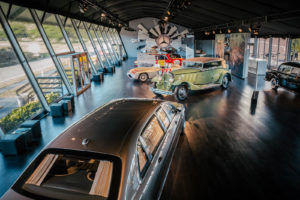
& Tent Rentals.
Tented events tend to be subject to the same wishes and whims as other segments of fashion and lifestyle industries. Hot event themes, decor preferences and color schemes change as quickly as the weather. (Remember when everything was chocolate and turquoise?) But sometimes what starts as a fad or trend has long-lasting effects on the industry.
Let’s examine three trends that appear destined to change the way tents are used in the event world: exhibition structures, engineered products and sailcloth tents.
Exhibition structures
For the world’s most prized collector cars at the renowned Pebble Beach Concours d’Elegance—the beauty contest of the auto world—it’s all about standing out from the competition.
“Each year [automobile companies] try to outdo each other,” says Keith Krzeminski, vice president of strategic accounts for Classic Event & Tent Rentals of Inglewood, Calif. “They
want to be the star of the show.”
In the years that Classic has provided structures for the event, Krzeminski has seen the installations go from standard to stand out.
“In the beginning, the displays were primarily standard tent inventory with cars outside,” he says. “They transitioned into tents that are, from a design perspective, more creative and architecturally intriguing. Tents are now outfitted with accessories such as glass, doors and hard walls. The insides are finished with high-end liners, custom display elements and hardwood floors or customized floor coverings in the colors of the automobile company or with their logos. It’s a luxury feel, from the outside plants to the glass walls to custom graphics.”
The desire for a custom space isn’t new. Alex Kouzmanoff, vice president of Aztec Tents in Torrance, Calif., says that in the marketing arena, there’s always been a demand for something different. But looser budgets have upped the call for one-off installations. “It’s more a factor of the economy and business in general. Five years ago, our clients couldn’t even think about coming out with something crazy, but now it’s a different time.
“The customer is demanding more from tent vendors,” he adds. “It comes from products becoming more readily available in the marketplace, which allows them to get used for other activities in places that before wouldn’t be considered.”
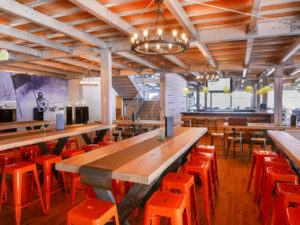
As events grow in size and sophistication, end users want to create “an experience where people don’t feel they are in a tent,” says Pat Moughan, general manager of Losberger US in Frederick, Md. “That’s evidenced by the amount of glass used to take it out of the world of all-vinyl canvas. As we moved to bigger and more aluminum-based products, you could get wider—clearspans up to 200 feet wide. The problem was it didn’t look as sexy as pole tents. Some of the things we have done are wrapping it so it has a big parapet around the top to light or use for graphics.”
Customers of Mahaffey Fabric Structures, Memphis, Tenn., want structures with higher sides, flatter roofs, covered framework and “way more window space” offering uninterrupted views, says George Smith, vice president and managing partner. “It seems like all the venues and high-end events want a lot of glass with very few supporting pieces. They also want a more contemporary style.”
Sky Curl, international business director for event design and fabrication for Denver, Colo.-based Condit, agrees that high-end structures are growing in popularity in the U.S., but he points out that they’re nothing new in Europe.
“I have been doing temporary structures for 16 years and traveling back and forth between Europe and the United States,” Curl says. “It always blew me away that there are more trade shows in the U.S. and fewer temporary structures. They don’t have the space [in Europe] for large convention centers, so people create their own spaces outdoors. That trend is starting to take shape here, but the indoor trade shows are always going to be predominant. The Las Vegas Convention Center probably has as much space as all the convention centers combined in the United Kingdom.”
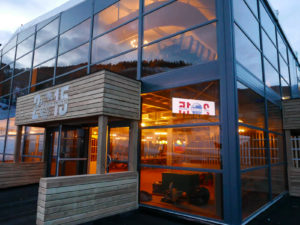
High-profile, high-dollar sporting events such as PGA tournaments also drive the move toward more elaborate setups, says John Fuchs, general manager, special events for Anchor Industries Inc. in Evansville, Ind. With clearspan structures, he says, “there are so many things you can do, like add porticos and cantilevered tops. You can have an area outside the tent with a covering and more structure behind glass. You can’t do that very well with a [traditional] tent.”
“I think the U.S. tent market will increase moving forward,” Curl says. “I just think there is a clientele that wants to create an image to go along with that functional space. They’re going to create a space specific to them.”
Engineered tents
All the attention on large, custom, stand-out temporary structures is great for the tent industry, but it comes at a price.
“Most of the sites we are doing now require site-specific engineering, not just stamped engineering,” Smith says. “They want it engineered for the venue and event. Local officials don’t understand tents and [requiring engineered products] shifts the liability off the town.”
One reason for increased scrutiny is widespread reporting of tent blow-downs that result in deaths and injuries, says Carol Cundey, marketing manager for Eureka! Tent Division of Johnson Outdoors Gear Inc. in Binghamton, N.Y.
“Even though blowdowns account for a minority of installations, because of media coverage, code officials want to ensure tents set up in their areas will withstand certain wind loads,” Cundey says.
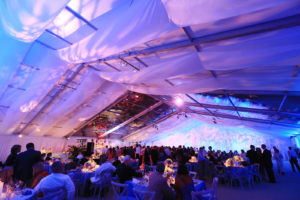
that was separated by an interior gable draped with custom panels. Photo courtesy of All Occasions Event Rental.
The demand for engineered tents, Moughan says, “has become more of a standard now, rather than a trend. What I see more of a trend with engineered products is in the smaller structures, something 20 feet wide, that need to have an engineered stamp on it.”
Municipalities are requiring more accountability and responsibility from tent rental companies, Krzeminski says. In response, equipment manufacturers and trade associations are providing engineering and tools that help tent rental companies respond in a professional manner. “Safety is everyone’s biggest concern,” he says.
Increased demand for tents for long-term applications also figures into a greater need for engineered products, Fuchs says. “This typically requires engineering to meet permanent building codes, which is usage greater than 180 days,” he says.
There is still a market for nonengineered tents, he notes, pointing out that, in addition to tents bearing engineering stamps, there are tents certified to certain parameters.
“Unfortunately, some of the rates that tent rental companies charge don’t support an engineered or certifiable tent, which requires a larger beam size extrusion, more reinforcement and fabric constructed to meet engineering requirements,” he says. “With an engineered tent, you have to charge
a rate that is probably not going to be doable in certain areas or with certain customers.”
Moving to engineered products can be a challenge for tent rental companies that have built up inventory of specific tent-frame components over a decade or more. But there can also be cost savings in upgrades to newer designs and technology, Kouzmanoff says. Potential savings, coupled with increased regulation, result in significantly higher demand for engineered products.
“Authorities having jurisdiction [AHJ] understand that tents certainly have a place in the world, but that you need to be careful,” he says. “When you are amassing a couple hundred people under a tent, that’s a potential life-safety issue if something were to go wrong. Products that were available 20 to 30 years ago just aren’t cutting it.”
Some tent rental companies, such as All Occasions Event Rental in Cincinnati, Ohio, aren’t taking chances.
“Any new product we purchase or consider purchasing must meet all existing code requirements,” says Tommy Wilson, director of event services. “We are not buying any nonengineered inventory these days.”
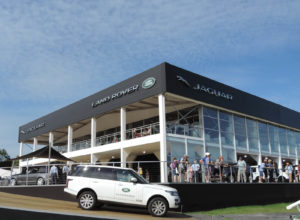
Sailcloth tents
Thanks, Martha Stewart. When the maven of all good things began showcasing weddings using sailcloth tents in her magazine, they “caught on like wildfire,” Fuchs says.
“The translucent tents glow and you can do very dramatic things,” he says, adding that part of the drama comes from variable peak heights.
Sailcloth tents have brought back an aesthetic of the form of the tent and the natural beauty of light, says Aztec’s Kouzmanoff. The company’s Tidewater® Sail Cloth Tent website lists a network of 120 rental companies across the United States and five overseas.
“What started out as five or six rental companies eight years ago has exploded in all different types of markets, from rural environments to metropolitan areas,” he says.
All Occasions Event Rental purchased its first sailcloth tent in 2013 and now owns three. Wilson says that the tents lend themselves to a farm or coastal style and a softer, more romantic look than a traditional high-peak tent. And with more manufacturers offering sailcloth tents, it’s no longer cost prohibitive for a rental company to invest in them.
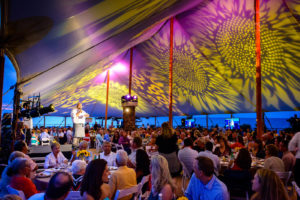
“A small company can buy one and do very well,” he says.
The popularity of sailcloth tents complements another enduring trend of rustic, shabby chic decor such as mismatched chairs and wine barrels, says Kouzmanoff.
“It might be a fad. It might stick around another 10 years,” he says. “But it’s certainly an important piece of the industry that wasn’t there five to eight years ago. Tent rental companies can charge rates that are significantly higher for a product that is different from a ho-hum, totally white tent.”
Janice Kleinschmidt is a freelance writer based in San Diego, Calif.
 TEXTILES.ORG
TEXTILES.ORG


